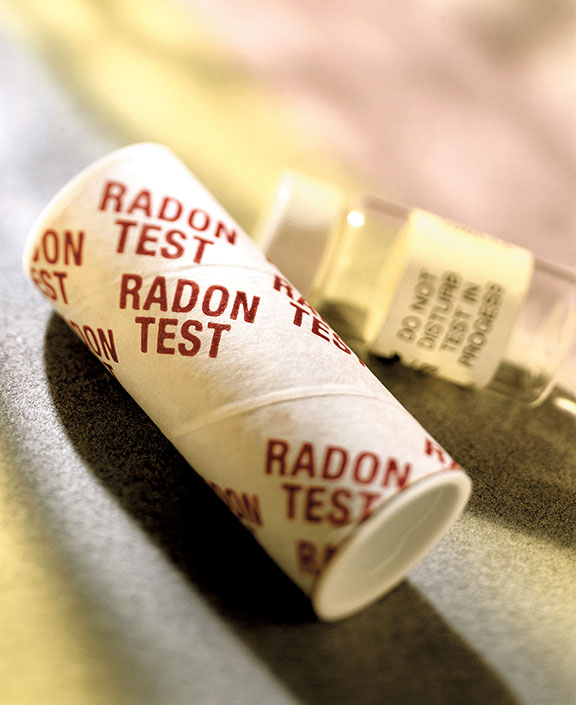
By Sunayana Prabhu
HOLMDEL – Cigarette smoking is the leading risk factor for lung cancer but a lesser-known cause among nonsmokers is something that potentially lurks in the home of every Two River-area resident: radon gas. State and local officials want residents to test their homes for this undetected radioactive gas that could be fatal over time.
“There is no safe level of radon,” said Jason Elliot, a radon measurement and mitigation specialist certified by the New Jersey Department of Environmental Protection (NJDEP). Radon is the second leading cause of lung cancer, he said, noting that environmental agencies consider even 1 or 2 picocuries per liter (pCi/L) of radon in indoor air unsafe.
Anything over 4 pCi/L would require mitigation, “but I don’t want anybody to panic,” Elliot said. Radon is a naturally occurring gas that people breathe in all the time; the whole idea is to minimize it as much as possible. The “real risk” he said is from “long term chronic exposure of 10, 15, 20 years of living in an environment and breathing that elevated radon.”
According to the Environmental Protection Agency, the average radon level in American homes is about 1.3 pCi/L and homes in Monmouth County are not immune. “It certainly is an issue in Monmouth County and in the Two Rivers area,” said Elliot.
The NJDEP classifies high-risk radon areas in the state in tiers, with tier one being areas with the highest levels of radon and three the lowest. Two River area towns with tier one ranking are Holmdel, Shrewsbury and Little Silver.
Elliot said his team also regularly addresses radon issues in homes in Fair Haven, Middletown and Rumson. The team recently successfully mitigated a home in Shrewsbury with a radon level of 50 pCi/L which Elliot deemed “very high.”
“It was probably the highest I’ve ever seen,” he said.
Holmdel was among a number of municipalities in the state that received radon awareness grants from NJDEP’s Radon Program to help residents test their homes for the insidious gas. Elliot’s company, Certified Environmental Contractors, LLC, was approved by the township to provide radon home test kits for the residents.
In a proclamation announcing Radon Action Month in January, Holmdel Mayor DJ Luccarelli stated, “prolonged exposure to radon can kill as many as 500 people in New Jersey each year, families who reside in homes with elevated radon levels are at risk of developing serious health problems, and any home could have high levels, even when neighboring homes do not. Radon testing can be done with great ease at a relatively low expense to the homeowner.”
Radon is an odorless, invisible, tasteless, radioactive gas that emits from the breakdown of naturally occurring uranium and rock in the soil. “But it doesn’t occur everywhere,” Elliot explained. Along the coastal plain of southern New Jersey “it’s less of an issue,” he said, but when you get to Monmouth County, the geology of New Jersey starts to change. “As you move up through the foothills leading up toward the mountains up north” the levels increase, Elliot noted. “Radon is certainly an issue for central Monmouth County because of that.”
Most people aren’t aware radon is an issue until they either buy or sell a home and the required radon testing is done by a home inspector. But the NJDEP recommends that homeowners test for radon themselves or hire a New Jersey-certified radon measurement business to perform the testing.
Beginning Feb. 6, Holmdel residents are able to pick up one free radon test kit at the Recreation Department window in Town Hall, from 9 a.m. to 4 p.m. Monday through Friday. The township has announced in a release that there are a limited number of test kits, and they will be available until supplies run out.
Some certified radon measurement businesses sell test kits by mail and test kits from certified businesses are available at hardware stores or home centers or online. Costs begin around $10 for the kit; once used, the kit is sent to a certified lab for reading, which often involves an additional fee of around $40. Test kits which include the lab fee are available for purchase at a discount – under $20 – through National Radon Program Services at Kansas State University. More information and links to purchasing test kits can be found through the EPA at epa.gov/radon.
If the test indicates a radon problem, radon mitigation systems can be installed. According to the EPA, “the National Radon Action Plan sets a goal for the nation to find, fix and prevent high indoor radon levels in 8 million buildings by 2025 and prevent 3,500 lung cancer deaths per year. Under this Plan, leaders from across multiple sectors are working together to plan, guide and sustain nationwide action to prevent exposure to radon.”
The article originally appeared in the February 16 – 22, 2023 print edition of The Two River Times.














